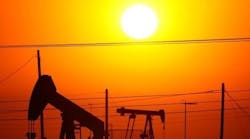In case you didn't have time to listen to Friday's Big Oil earnings calls, here's a summary:
Exxon Mobil (IW 500/1): We have a tremendous business model built for the long term ... but almost a fifth of our proved reserves might disappear come the New Year.
Chevron (IW 500/5): Whew! We finally made some money, and ... oh, did we mention our assets in the Permian shale? We did? Well, just to reiterate, we're big in the Permian. That's right: Permian. With a "P".
The market liked the second one better, it turns out. Chevron's stock rose by almost 4%, while Exxon's fell by 2.5%. These are big moves when you're talking about almost $550 billion of combined market cap.
Taking Exxon first, it announced low energy prices could force it to de-book 4.6 billion barrels-equivalent of proved oil and gas reserves. Physically, they still exist. They just don't meet the test for being "proved" based on trailing oil and gas prices, so they have to go (for an explainer on this, see here). As and when prices rise, they could be added back.
It's still a big deal.
For one thing, it's another embarrassment for Exxon in what has been a humbling year already.
It also presses on Exxon's biggest sore spot: replacing its reserves. The company didn't manage this in 2015 because it had to de-book more than 580 million barrels-equivalent of reserves, mostly U.S. gas, due to the same issue of low pricing. Taking off 4.6 billion would be equivalent to about three years' worth of production.
Of that total, 3.6 billion relate to one asset, the Kearl oil-sands project in Canada. Developing this type of mega-project is kind of the whole reason Exxon and its peers exist in the first place.
Compounding the misery, Exxon also said a review of its asset portfolio could lead to impairments due to low prices. Exxon may have felt it necessary to speak to this issue because of recent questions raised on how it has avoided write-downs so far. But with its own CEO Rex Tillerson telling everyone not to expect a big rebound in oil prices, an actual impairment could be coming.
This all ties back to the other embarrassment Exxon suffered earlier this year, when Standard & Poor's cut the company's triple-A credit rating, specifically calling out replacing reserves as "the company's greatest business challenge."
With its Russian expansion plans stymied for now, Exxon's long-term growth prospects look beholden to high-cost things such as liquefied natural gas and, yes, Canadian oil sands. More than ever, it looks like Exxon needs to rejigger its portfolio, possibly with an acquisition, to deal with the lackluster price environment it foresees.
Chevron, meanwhile, appears to have gotten a head start on such rejiggering.
This is partly due to timing. Chevron's CEO, John Watson, famously said in early 2014 that "$100 a barrel is becoming the new $20" -- roughly six months before oil prices began the swan dive taking them close to $20 by early 2016.
Such bullish thinking -- not confined to Chevron by any means -- spawned a series of giant development projects such as Gorgon LNG in Australia. These busted through budgets and schedules, taking down cash flow and return on capital with them.
But with those projects now producing, or close to it, Chevron has taken most of its licks already. And now, having mostly stopped beating the drum for an imminent rebound in oil prices, it has a far better sales pitch -- which beings with "P".
The Permian basin, mostly in Texas, has kept chugging along in the oil crash even as its cousins in the Bakken shale and elsewhere have succumbed. Exploration and production companies focused on the Permian have left their peers in the dust:
Land values there have soared as E&P firms and private equity have tried to establish or consolidate positions. An acre usually changed hands for $20,000 or less a couple of years ago; now it's more likely to go for at least double that.
Hence, while the Permian only accounts for about 6% of Chevron's output, analyst valuations of the company's assets there are much bigger. Citigroup recently put it at between $50 and $60 billion, or up to a quarter of Chevron's enterprise value. Even allowing for the usual sell-side exuberance and the tendency of E&P firms to bid up land, that makes it a bedrock asset for the company.
The Permian's real advantage, though, is that it represents good rocks in a good neighborhood -- politically speaking -- that can be developed quickly and with the possibility of further productivity gains.
In other words, and at the risk of stating the obvious, Texas ain't Canada or Russia.
Exxon also has a lot of acreage in the Permian shale, but it is gassier than Chevron's. What Chevron has in the Permian is a means to smooth out the lumpiness of spending and production, inherent to mega-projects, that bedevils Big Oil. It can offer a more credible path to raising output and keeping costs in check in the near term until larger projects elsewhere come onstream.
Does it solve everything? No. Chevron is still borrowing to pay its dividend.
But, then, so is Exxon. And, as I explained here, Exxon's stock has less leverage to oil prices than most rivals, with its appeal resting chiefly on its apparent invulnerability.
That's just less apparent these days -- which makes the valuation gap between the two oil majors ever more so.
By Liam Denning



